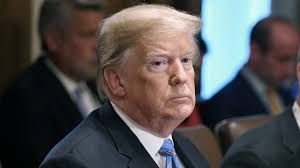What Trump’s Brief Flirtation With a Payroll Tax Cut Says About the State of the Economy

It probably shouldn’t come as a surprise by now, but President Trump’s reversal Wednesday on potential payroll and capital gains tax cuts—proposals he had mooted only 24 hours before—was abrupt by even his own standards.
To backtrack: on Tuesday, the President said that his administration would consider slashing both payroll taxes, which fund government programs like Medicare and Social Security, and capital gains taxes, which are taken out of investors’ profits, in a bid to further stimulate the economy. For many, it was a sign that President Trump was finally concerned about the overall health of the U.S. economy in the wake of lagging indicators and stock market volatility in recent weeks.
Of course, the President has now changed his mind, telling reporters on Wednesday that the U.S. “[doesn’t] need” further stimulus, given the fact that we already “have a strong economy.” But what’s clear is that things aren’t rolling like they were over the course of last year and earlier this year—whether that’s because of the U.S.’s ongoing trade war with China, as many observers would claim, or the Federal Reserve’s reluctance to drastically slash interest rates, as the President himself has stressed.
The question, then, is not only whether President Trump will yet again revert to tax cuts should economic conditions continue to slow down, but whether the cuts he suggested would actually have the desired effect of improving the economy. Like previous Republican administrations, Trump’s has relied on tax reform as its favored means of bolstering economic growth (see: the Tax Cuts and Jobs Act of 2017). Yet cutting payroll and capital gains taxes would be unorthodox moves impacting very different segments of the American economy.
The Trump administration has long considered taking action to reduce capital gains taxes, which primarily apply to wealthy individuals as they’re paid on the profits received from investments (think stock proceeds and property transactions). A payroll tax cut, on the other hand, would boost the take-home pay of many working Americans; the Obama administration implemented a temporary, two-year payroll tax cut in 2011 and 2012 as the U.S. economy continued to recover from the Great Recession (a move opposed by House Republicans at the time).
But when it comes to providing a jolt to the economy, it’s unclear whether capital gains tax reform would do more than help wealthy investors already benefiting from altogether robust capital markets conditions. And while a payroll tax cut would undoubtedly stimulate the pocketbooks of a huge swath of Americans, consumer confidence and spending levels remain strong and it would likely further drain government coffers that are already on pace to hit a $ 1 trillion deficit.
For some observers, the Trump administration’s exploration of tax cuts as a means to further boost the economy is an admission that the last such measure it pursued—the sprawling Tax Cuts and Jobs Act of 2017—has failed to yield the desired results.
“The administration based the big 2017 tax cut on the idea that it would spur economic growth,” says Matthew Gardner, a senior fellow at the Institute on Taxation and Economic Policy, a non-partisan think tank based in Washington, D.C. “At a time when there’s little evidence that it’s doing so, they’re under pressure to find some other tax-based means of doing that.”
Gardner notes “widespread public skepticism” that the tax reform law was “designed to help middle-class families and create jobs,” rather than primarily benefiting “large corporations” through its cutting of the corporate tax rate and other provisions that have helped large companies. Likewise, capital gains tax reform would be “basically irrelevant to most lower-to-middle-income families,” he says.
And while a payroll tax cut would represent a far more balanced way of encouraging consumer spending and stimulating growth, Gardner adds that the argument for tax reform that would “further endanger the sustainability of our budget” is weak at a time of relative economic prosperity.
“At a time when stimulus is obviously needed, a payroll tax cut would be a far superior approach to doing it than the high-end tax cuts we’ve enacted in the last couple of years,” he says. “But it’s far from obvious that we need more stimulus at this time.”
Like many of the maneuvers coming out of the White House these days, it’s likely that the Trump administration’s flirtation with further tax cuts is heavily informed by political considerations, given that 2020 is right around the corner. A strong economy would undoubtedly bolster the Trump campaign reelection chances, and with the Federal Reserve reluctant to slash interest rates too quickly without the economic data to justify such a move, the President could well be “realiz[ing] that he’s going to have to do some of this on his own,” according to Gibson Smith, founder of investment firm Smith Capital Investors.
“There’s only so much that central banks can do; quantitative easing has stabilized the markets, but it has not spurred the growth that was anticipated,” Smith says, citing slowing manufacturing data among “indicators that show the economy is getting weaker.”
In the end, it likely all comes back to what the President himself has been reluctant to accept: that it is the ongoing trade dispute with China that has proven the greatest headwind to sustaining the longest economic expansion.
James Ragan, director of wealth management research at D.A. Davidson, blames “tariffs and trade uncertainty” for slowing business spending figures in recent months. He adds that while a payroll tax cut would help consumers “offset the impact” of tariffs on goods imported from China, the noises coming out of the White House indicate no end in sight to the trade war.
“It tells me that there isn’t going to be a quick resolution on the China trade [dispute],” Ragan says. “This shows me [Trump’s] willingness to push forward with the tariffs.”
More must-read stories from Fortune:
—Will gaffes hurt Biden’s chances of a 2020 win? Strategists are divided
—Trump says the economy is doing great, but these economists fear recession by 2021
—What is BDS? Boycott, Divestment, and Sanctions explained
—When does Congress reconvene? August recess, explained
—Trump thinks he is winning the trade war, but the data tell a different story




